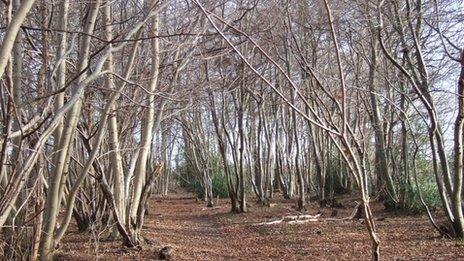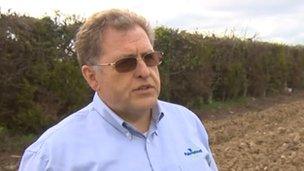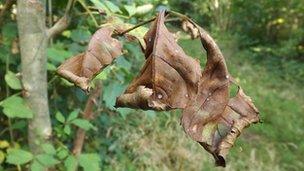Ash dieback: South East is 'low priority'
- Published

Nearly 500 cases of ash dieback were found in the UK last year, most of them in Kent and East Anglia
Nearly 500 cases of ash dieback were found in the UK last year, most of them in Kent and East Anglia.
And as ash trees come into leaf this month, experts are waiting to learn how many more have been infected by the fungal disease since it reached the UK's woodlands last autumn.
The government has launched a management plan to replace ash trees with other species to preserve forests.
But the South East has been declared a "low priority" area - authorities say that because the disease is already widespread, it is not cost effective to tackle it.
Other areas will be able to apply for government grants to remove infected trees.
'Money and effort'
Dr Alun Griffiths, microbiologist and chairman of the Kent Men of the Trees conservation charity, said the county needed better protection.
"I've been studying diseases around the world all my professional life," he said.
"I've always thought that if you have a focus, an area where disease is being spread rapidly, that would be the place where you'd put most of your effort.

Nick Coslett, from Palmstead Nurseries, said the government's response was "too little too late"
"And if Kent is, as I understand from the maps, an area such as that, I would have thought it made sense to put some effort and money into this area too."
Some ash growers have said they are considering legal action for compensation after ash trees were burnt due to a movement ban, which meant they could not be sold.
Nick Coslett, from Palmstead Nurseries in Ashford, said: "I don't think the government response has been good enough.
"Too little too late, they haven't helped enough yet and all the nurseries and all these small businesses are carrying the can at the moment."
Labour has accused the government of abandoning the South East to the disease.
'Long-term solutions'
The government is planting thousands of young ash trees in the region as part of a research trial, including at the Hucking Estate near Maidstone.
Scientists hope 1% of them may survive and develop resistance in a decade's time.
Martin Ward, chief plant health officer at the government's Food and Environment Research Agency, said the South East was "high risk" because it seemed likely that the disease had spread from the Continent by aerial movement of spores on the wind.

Some ash growers have said they are considering legal action for compensation
He said: "The modelling that we've commissioned by a team at Cambridge University suggests that the cost of interventions like removing recently-planted infected plants; the benefits of that intervention are likely a bit higher in areas where there are very few or no wider environment cases."
He said the response was about "prioritising the interventions that we can make".
He said research, including screening trees for resistance and possible fungicidal treatment, were of potential benefit to the areas where ash dieback was most prevalent.
"It's a long-term problem and we're looking at long-term solutions such as the identification of resistant strains," he added.
- Published12 May 2013
- Published10 May 2013
- Published10 May 2013
- Published7 May 2013